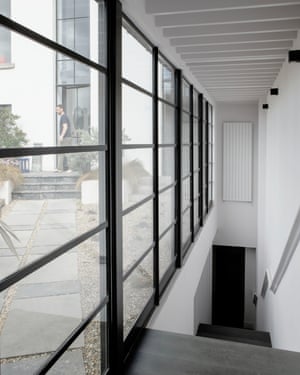Dublin storeys: how two townhouses have been introduced again to life | Interiors

Behind each historic facade lurks a story of social and financial upheaval. Take these belching, satanic factories which as soon as lined the waterways of Britain. Now many of those relics of the Industrial Revolution have been cleaned up and transformed into residences, and rebranded by property brokers as fascinating waterside dwelling. Or contemplate these grandiose Edwardian banks with their forests of fats stone columns and coffered ceilings, doomed by digital disruption to be turned from temples of commerce into members’ golf equipment or all-day consuming dens.
Colm Doyle’s Dublin dwelling has had a equally tumultuous previous. Constructed within the early 19th century for affluent Anglo-Irish attorneys, the 2 adjoining townhouses have been purchased by a constructing society within the 1960s. The brickwork was clad in what Doyle, an architect, calls “modernism on a budget” – concrete slabs and the bottom ground knocked into an open-plan area with a sprawling extension added on the again. Then got here the credit score crunch of 2008. The financial institution collapsed and the five-storey constructing slid into decay earlier than it was repossessed by the state.
“After we first noticed the place it had been empty and available on the market for a number of years,” says Doyle, who shares the home along with his accomplice, Peter O’Reilly. “There was dry rot, and the basement was flooded.” However Doyle, who heads up DMVF, a thriving architectural apply within the metropolis, educated his gaze past the dereliction: “We have been on the lookout for a bigger place within the centre of city with a good out of doors area. Other than mews homes or trendy residences, Dublin’s housing inventory is fairly skinny. This place answered our wants. I used to be impressed by the concept of respiratory new life into an previous constructing.” At first the worth was too excessive. Three years later, after promoting their residence, Doyle returned, emboldened. “We put in a ludicrously low supply and have been accepted.”
To fund the undertaking, Doyle determined to lease the bottom ground to a restaurant. “It additionally fitted the character of the world, which is filled with retailers and native companies,” he says. Upstairs, three flooring have been knocked via to create a light-suffused, three-bedroom home or what Doyle smilingly refers to as “dwelling above the store”. At road degree, Doyle designed the classical entrance door, a “lie” made up of stone steps and stucco columns found within the basement: “It captures the standing of the 19th-century constructing.” The sash home windows have been restored and the “ferociously broken” brickwork repaired and rubbed with soot to match the unique bricks.

Behind the frontage, Doyle, who’s a conservation knowledgeable with Modernist leanings, was eager to demarcate between previous and new parts: “By making a distinction between the unique structure and trendy interventions you inform the story of the home clearly,” he says. The brand new staircase, which glides from floor to first ground, is created from charred oak for a minimalist really feel and contrasts with the unique twirling stairs on the prime of the home. On the again, a elevate used to haul cash from money tills to retailer rooms was changed with a glazed double-height area the place Crittall doorways result in a roof terrace.
Doyle enlisted gardener Mark Grehan to design the planting for what was as soon as a “revoltingly ugly” flat roof: tender grasses, bamboo, alliums and lavender which fade from inexperienced to silver in winter. Doyle additionally designed the raised mattress which screens the eating space, including vertical strains of slate paving to echo the Mondrian strains of the extension.
Earlier than the financial institution moved in, the homes had been divided into bedsits however, fortunately, some Regency particulars stay. On the primary ground, the place ceilings soar to 11ft 6in, the shutters are unique and Doyle restored the pine flooring. He designed the double doorways which hyperlink drawing and eating room, based mostly on 19th-century originals. The 2 fireplaces, which body the area like a comfy embrace, have been present in a skip and painted to match the pebble-grey woodwork.

For a very long time the rooms have been empty. “We had a sequence of derelict dinner events over three weeks; one every week for mates after which for household.” Afterwards, Doyle’s mother and father purchased them the 12ft lengthy, 18th-century eating desk, its “seriousness” offset by Fornasetti plates and strutting flamingo lamp.
There may be area for visitors within the kitchen, a “vivid, white” distinction to the standard reception rooms. The cabinetry is bespoke however the ground is a cheat: tiles minimize up and laid in a herringbone sample for a poor man’s parquet impact or, as Doyle places it, “As an architect it’s my job to give you cost-effective concepts.” Within the lavatory, marble offcuts from the kitchen have been repurposed to make the self-importance unit. Within the hallway, the placing paintings seems to be a chunk of handblocked wallpaper, set in an vintage body as a tongue-in-cheek nod to the constructing’s grander roots.
There may be one other relic on the terrace the place the previous constructing society signal is propped nonchalantly towards the wall. Like every part else, the signal has develop into a part of the material of this singular constructing, a reminder of the chequered narrative which lies behind each historic home.
DMVF Architects (dmvf.ie). Make the House You Love, by Fiona McPhillips with Colm Doyle, is printed by O’Brien Press at £16.19